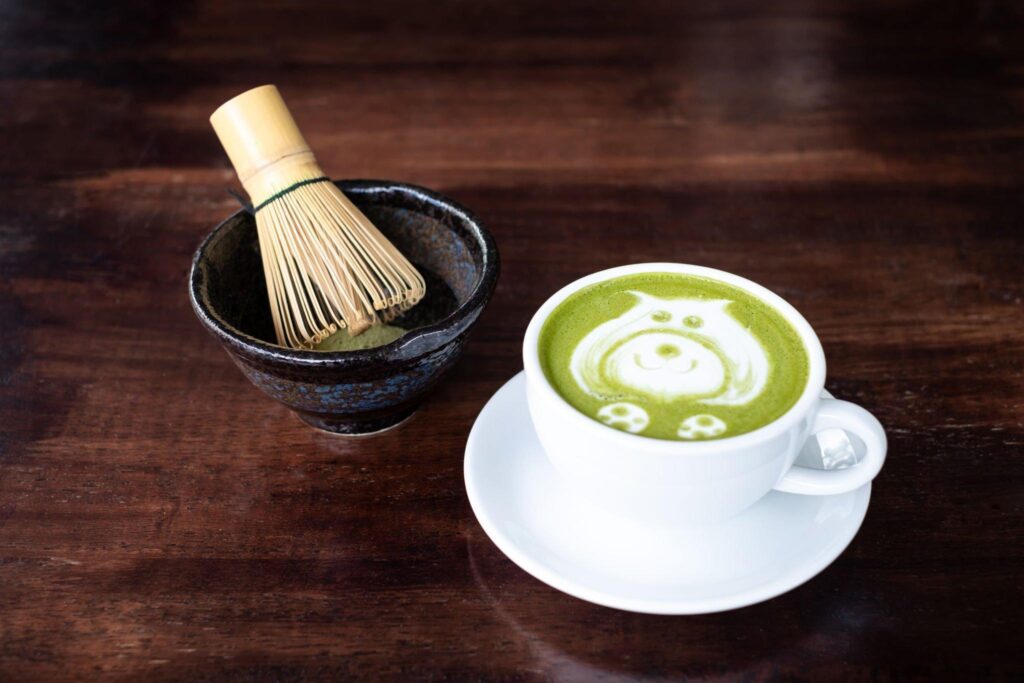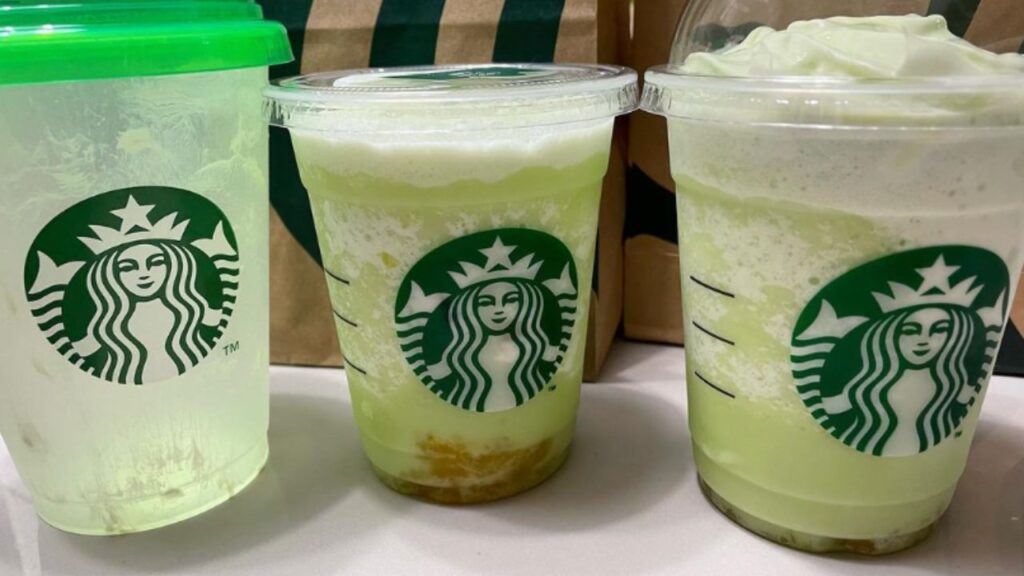Starbucks matcha drinks are gaining popularity, and, like any food or drink, the quality of the ingredients is a big part of creating their signature taste.
Starbucks uses Aiya brand matcha in their matcha powder, though the mix they’ve created for their drinks and retail sale is their own.
Matcha is a popular and culturally important drink in Japan, but its popularity in the rest of the world is a more recent phenomenon. Starbucks matcha lattes might even be your first exposure to this popular and delicious drink!
But, if you know much about coffee, you probably already know that Starbucks drinks might taste good, but they aren’t always made well. Here’s what you need to know about Starbucks matcha, from the Aiya matcha they use to the differences between a Starbucks Matcha Latte and the matcha drunk during a traditional Japanese tea ceremony.
What is Matcha?

Matcha is more than just a popular drink. It can also be used in cooking, especially making desserts, and also has important cultural significance.
All matcha is made the same way. High-quality green tea leaves are dried and then ground into a fine powder. Depending on the tea in question it might have different techniques used to bring out the flavor and prepare the tea during the drying process.
Most often, fine ground matcha is whisked into hot water to create a rich and frothy drink. It tastes and feels different from regular green tea, and often has a more intense green tea flavor.
Matcha is the drink served during Japanese tea ceremonies, and both the quality of the matcha and the quality of its preparation are highly prized in Japanese culture.
Is it healthy?
Like a lot of other teas, matcha is thought to be very good for you. It is high in antioxidants, which can help prevent free-radical damage in your body. It’s also thought that matcha might have some protective benefits for your liver and that drinking it can help your liver function better longer.
However, matcha also has a high concentration of caffeine, higher than other green tea. Caffeine has some health benefits, but it can also be harmful if you drink too much of it.
In addition to the caffeine content in matcha, the drink also comes with a healthy dose of L-theanine, which can actually improve the effects of caffeine and help reduce the risk of a caffeine crash compared with other sources.
Depending on your needs and diet, drinking matcha can be a healthy addition to your day. However, drinking in moderation is important, and matcha that’s loaded down with sugar and cream or other additives still comes with all the calories and health effects of those other ingredients.
What are the benefits of Matcha?
There are a lot of potential benefits from drinking matcha or adding matcha to your cooking and baking. However, a lot of those benefits still need more scientific research to be proven.
We’re going to focus on the potential benefits of drinking matcha, but future science may still prove some of these ideas wrong, or prove additional health benefits that we don’t know about yet.
Matcha is thought to improve health in a few different ways. It can help protect your liver, reducing the amount of liver enzyme in your body, and reducing the risk of developing fatty liver disease.
It is also thought to have a protective effect when it comes to cancer risk. Drinking matcha regularly may slightly reduce your risk of developing a range of different cancers. However, the tests showing these benefits have so far been confined to test tube and animal studies.
You may also receive heart health benefits from drinking matcha and other forms of green tea. It’s been shown to have more positive effects on heart health than coffee, and may also help reduce high blood pressure in people who already have heart disease.
Other benefits include increased energy and concentration. It is also thought that green tea and matcha may be helpful for people who are trying to lose weight. Matcha is thought to increase your metabolism, increasing the amount of time your body is burning fat throughout the day.
What Type of Matcha Does Starbucks Use?
A lot of people’s first exposure to matcha comes from Starbucks. No surprise since Starbucks is one of the leading coffee and tea providers in the world.
However, when it comes to the actual quality of their drinks, Starbucks doesn’t always have a great reputation. From overly bitter coffee or over-sweetened drinks, the restaurant is known for taking shortcuts and using added ingredients to make their drinks more palatable.
When it comes to their matcha, Starbucks does some things right. Their matcha is Aiya brand, which is a Japanese brand, but there’s more to finding great matcha than choosing a Japanese producer.

What is Aiya Matcha?
Aiya matcha is a well-known Japanese brand, and it has middling quality when it comes to matcha. If you’re used to buying the most affordable matcha you can find and drinking that, Aiya matcha is probably a step up from what you’re used to.
However, Aiya matcha isn’t the best matcha on the market, and most matcha lovers would opt for an even better brand if they can afford it. It’s not ceremonial grade matcha either, and Starbucks’ matcha powder isn’t pure matcha.
What is Starbucks Matcha Powder Made From?
Starbucks matcha powder is what’s used to make matcha drinks in Starbucks locations, and also the version of matcha that the restaurant sells retail.
Instead of being pure matcha, Starbucks matcha powder is a mix of matcha, sugar, and fruit pectin. This blend helps make matcha sweeter, less sensitive to temperature, and slightly thicker and richer feeling.
However, matcha purists wouldn’t call Starbuck matcha real matcha, because the drink is supposed to be made on its own, without any additives.
Are There Any Additional Ingredients in Aiya Matcha?
That depends on which kind of matcha you buy from Aiya Matcha. The brand has several different products, including pure matcha along with sweetened or flavored versions of the powder.
There’s nothing wrong with drinking matcha with other ingredients or additives, but the benefits of the matcha may be diluted.
Is Starbucks Matcha Authentic or Fake?
The answer to this question is mixed: Starbucks matcha is made with real matcha, but it’s not really an authentic version of the drink.
Authentic matcha is drunk by itself. No sugar or other ingredients are added. The temperature of the water, the amount of matcha used, and the preparation (how long or vigorously you whisk the matcha) all influence the flavor of the finished drink.
But Starbucks isn’t a Japanese teahouse, and you won’t find anything like a Japanese tea ceremony on the menu.
Instead, Starbucks matcha has a lot of the same flavor and some of the benefits of traditional matcha, but with plenty of added ingredients like sugar, cream, coffee, or milk, to make the drink sweeter and add different characteristics.
Starbucks matcha is also served both hot and cold. Authentic traditionally prepared matcha is always hot.
What Starbucks Beverages Contain Matcha?

All Starbucks Matcha drinks, and most of their green tea drinks, contain matcha. That includes:
- Matcha Tea Lattes
- Iced Matcha Tea Lattes
- Matcha Lemonade
- (discontinued) Pineapple Matcha Drink
- Matcha Crème Frappuccino
- Emperor’s Clouds & Mist
- Iced Peach Green Tea Lemonade
Of course, the restaurant has a history of changing its drink menu, so you may be familiar with some new matcha drinks that aren’t on this list. Or, some of the current drinks on the list might be discontinued in the future.
Is Actual Matcha better than Starbucks Matcha?
That probably depends on why you’re drinking matcha and your personal taste. Starbucks isn’t really trying to replace Japanese tea houses or other matcha competitors. Instead, Starbucks’ matcha drinks are more about adding a unique flavor to the same formulas and ingredients they were already using in their teas, coffee, and refreshers.
Authentic matcha is going to have a much stronger matcha flavor, isn’t nearly as sweet, and is likely more concentrated than most Starbucks matcha drinks.
A lot of people love the taste of authentic matcha, but it can be bitter and astringent if you don’t prepare it correctly or aren’t used to the taste of high-quality green tea.
Starbucks matcha, on the other hand, tends to be a little thicker, less concentrated, much sweeter and often has other flavorings or additives to make it more palatable for customers used to sweet drinks.
You can still get some of the health benefits of matcha from a Starbucks drink but remember that there are going to be a lot more calories and other ingredients. So, the benefits you might be getting from the matcha aren’t going to be as strong, and they might be negated by the other ingredients.
Ultimately, you’re the only one who can decide if actual matcha is better than Starbucks matcha. Plenty of people will say yes, especially people who enjoy authentic matcha or have a cultural connection to the drink. But there’s a reason matcha has been a popular addition to Starbucks’ menu.
Conclusion
The matcha you get at Starbucks isn’t the same as the ceremonial grade matcha that is typically drunk by matcha lovers around the globe. That doesn’t mean that the drinks aren’t good, just that they aren’t the same as traditional matcha.
Aiya matcha is a well-known brand in Japan, and it uses an innovative range of flavors and additives to give customers a wider selection of their beverages. Starbucks brand matcha is similar to other Aiya matcha products.
All told whether you want to drink Starbucks matcha or try a more authentic brew is entirely your decision.
FAQs
Here are some of the most frequently asked questions we get about Starbucks Matcha.
Yes and no. Starbucks Matcha contains sugar and pectin, both of which have other effects on the drink. However, both sugar and pectin can also act as preservatives and make things more shelf-stable.
Pectin is a naturally occurring compound commonly found in fruits. It’s also what makes it possible to thicken jams and jellies made from whole fruit. In Starbucks matcha, the pectin creates a thicker texture, while also preserving the drink for longer.
There are a few reasons a lot of people think that Starbucks matcha is low quality. For one thing, the brand of matcha Starbucks uses is Aiya matcha, which is a relatively good brand, but not as high quality as ceremonial grade matcha.
Matcha is also traditionally served without any sugar or other ingredients aside from matcha and water.
Since Starbucks matcha drinks come with a lot of sugar, and often cream and other ingredients, that’s another reason people think Starbucks matcha is low quality.
Another big reason is how the matcha is prepared. Like all green tea, matcha is temperature sensitive, and the flavor changes quite a bit when it’s brewed too hot or too cold. Starbucks often brews their drinks too hot, including their matcha, which can make it more bitter than it should be.
Yes! High-quality matcha isn’t that hard to find, and making your own matcha at home isn’t all that difficult. All you need is the matcha, a measuring spoon, a kettle for the water, and a whisk.
If you want to go the traditional route, you can get a specialized bamboo whisk designed for matcha. But any old whisk that fits in a mug or bowl will work.
Want matcha like you get at Starbucks? Try adding a little sugar and some cream or milk. Honey, fruit juice, and even flavored teas or coffee-flavoring syrups can also be added, but those extra ingredients aren’t traditional.
Starbucks gets its matcha from Aiya, which is a Japanese matcha brand. Japan and China are the biggest producers of matcha in the world, but Japanese matcha traditions are older, and Japanese matcha is usually considered higher quality.
That said, Aiya matcha isn’t the best grade of matcha you can get, and Starbucks doesn’t use traditional preparation in their matcha drinks.
There are a few ways to get good quality Matcha in the US. One option is to order your matcha online. Look for ceremonial grade matcha and check the brand to make sure it’s a Japanese company with a good reputation.
If you live somewhere with an Asian or Japanese market nearby, it’s a pretty safe bet that they will also carry a range of matcha powders. Look for ceremonial grade for drinking, and culinary grade for making a variety of traditional treats. Or, ask one of the clerks which kind of matcha they recommend.
Lastly, a lot of tea houses sell matcha as well. If you have any tea houses in your city, you can ask them about matcha. Even if they don’t sell plain matcha directly, they might be able to point you toward some good brands you can buy online.
How useful was this post?
Click on a star to rate it!
Average rating 0 / 5. Vote count: 0
No votes so far! Be the first to rate this post.
